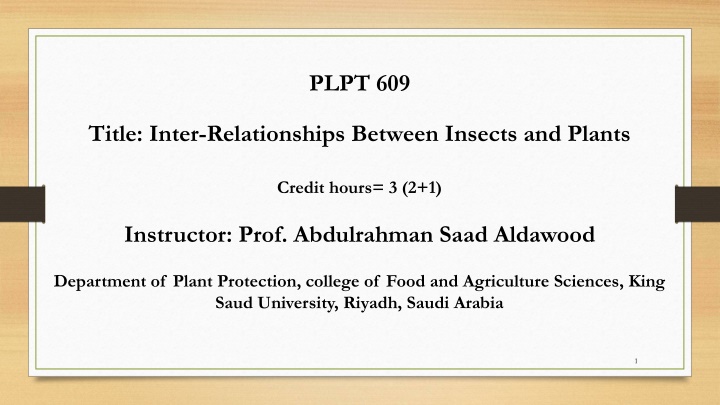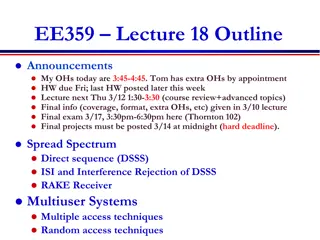
Interactions Between Insects and Plants via Allelochemicals
Explore the intricate relationships between insects and plants through the study of allelochemicals, plant secondary metabolites crucial for ecosystem health, agriculture, and pest management. Learn about the diverse roles of allelochemicals, including their impact on herbivores and predators, plant stress responses, and rare plant-insect interactions. Discover how these compounds play a key role in the survival strategies of herbivores and contribute to biodiversity conservation.
Download Presentation

Please find below an Image/Link to download the presentation.
The content on the website is provided AS IS for your information and personal use only. It may not be sold, licensed, or shared on other websites without obtaining consent from the author. If you encounter any issues during the download, it is possible that the publisher has removed the file from their server.
You are allowed to download the files provided on this website for personal or commercial use, subject to the condition that they are used lawfully. All files are the property of their respective owners.
The content on the website is provided AS IS for your information and personal use only. It may not be sold, licensed, or shared on other websites without obtaining consent from the author.
E N D
Presentation Transcript
PLPT 609 Title: Inter-Relationships Between Insects and Plants Credit hours= 3 (2+1) Instructor: Prof. Abdulrahman Saad Aldawood Department of Plant Protection, college of Food and Agriculture Sciences, King Saud University, Riyadh, Saudi Arabia 1
Contents Allelochemicals interactions among plants Herbivores and their predators Allelochemicals reflecting interactions between plants and pests Role of plant allelochemicals in the survival strategy of herbivores Rare plant-insect relationships Plant stress and Insect interactions 2
Allelochemicals Allelochemicals are plant secondary metabolites, compounds considered nonessential for the direct development of cells, released into the environment via root exudation, leaching by precipitation, volatilization, or decomposition of plant tissues Understanding these allelochemicals interactions is crucial for ecosystem health, agriculture, pest management, and biodiversity. The terms phytoallelopathy , zooallelopathy and microbial allelopathy are used to describe specific interactions with plants, animals and microbes 3
Allelochemicals A single allelochemical compound can confer resistance to multiple species, potentially of multiple kingdoms. How? Antagonistic interactions between a plant and other species. Hickman et al., 2021 4
Examples of some secondary metabolites of plants and their effects on target insect pests Pelden & Meesawat, 2019 Chen et al., 2020 Chen et al., 2020 Rostas et al., 2013 Sufang et al., 2013 Grote et al., 2013 Eniinemets et al., 2013 5
Types of Allelochemicals 1. Phenolic Compounds 2. Terpenoids (Isoprenoids) 3. Alkaloids 4. Fatty Acids and Lipids 5. Glycosides 6. Volatile Organic Compounds (VOCs) 6
1. Phenolic Compounds Plants require phenolic compounds particularly for resistance to insects and pathogens. Plants, unlike animals, cannot rely on physical mobility to escape their predators, thus, synthesis of many phenolic compounds is a useful defense mechanism against the crop pests Phenolic compounds can inhibit the growth of various pests and pathogens. For example, tannins can deter herbivores by making the plant less palatable Phenolic compounds have antifeedant, toxic and regulatory activity affecting insect physiological processes or repel the phytophagous insects 7
Common Phenolic Compounds 1. Phenol: 2. Catechol (1,2-dihydroxybenzene) 3. Resorcinol (1,3-dihydroxybenzene) 4. Hydroquinone (1,4-dihydroxybenzene) 5. Tannins 8
2. Terpenoids (Isoprenoids) Terpenoids, also known as isoprenoids, are a large and diverse class of organic compounds derived from five-carbon isoprene units. They are produced by many plants and play critical roles in plant defense, signaling, and ecological interactions. 9
Common Types of Terpenoids 1. Monoterpenes Examples: Limonene (found in citrus fruits), menthol (from mint), and pinene (from pine trees) Functions: Often contribute to the aroma of plants, serve as insect repellents, and possess antimicrobial properties 2. Sesquiterpenes Examples: Farnesene (found in apples) Functions: These compounds can deter herbivores and attract pollinators or predators of herbivores 10
3. Diterpenes Examples: Phytoene (precursor to carotenoids), and gibberellins (plant hormones). Functions: Involved in growth regulation and can have protective roles against pathogens. 4. Triterpenes Examples: Squalene (precursor to sterols) and betulinic acid. Functions: Have roles in plant defense and can exhibit medicinal properties. 5. Tetraterpenes Examples: Carotenoids (like -carotene and lutein). Functions: Important for photosynthesis and provide coloration in fruits and flowers, attracting pollinators. 11
Ecological and Agricultural Significance Pest Management: Due to their natural insecticidal properties, terpenoids are being researched for use in organic pest management strategies. For instance, essential oils containing terpenoids can repel or kill pests without harming beneficial insects. Defense Mechanisms: Terpenoids serve as chemical defenses against herbivores, pathogens, and competitors. They can deter feeding or even be toxic to certain pests. Attracting Beneficial Organisms: Some terpenoids attract pollinators and natural enemies of pests, contributing to ecological balance. Allelopathic Effects: Certain terpenoids can inhibit the growth of neighboring plants, reducing competition for resources. 12
Some terpenoids in plants and their activities in insectplant interactions Senthil-Nathan 2013 13
3. Alkaloids Alkaloids are produced by various plants and are known for their significant pharmacological effects on humans and other organisms Alkaloids can affect nerve transmission in insects, disturbing the cell membrane and cytoskeletal structure, causing the collapse and leakage of cells There are numerous plant alkaloids, such as nicotine, caffeine, morphine, colchicine, ergolines, strychnine, scopolamine and quinine 14
Types of Alkaloids 1. Pyridine Alkaloids Properties: Often have stimulant effects and can be toxic to pests belonging to the senecionine type, contain the compound senecionine N-oxide, which elicits a toxic effect against Spodoptera exigua. Examples: Nicotine (from tobacco), ) mediate plant defense in the form of feeding repellents. 2. Indole Alkaloids Examples: Morphine (from opium poppy), vincristine (from periwinkle). Properties: Known for their medicinal properties, but also exhibit toxic effects on herbivores. 15
Inter-Relationship with Pest Management Natural Insecticides Toxicity to Pests: Alkaloids such as nicotine and caffeine have been used as natural insecticides. They can disrupt the nervous system of pests, leading to paralysis and death. Sustainable Pest Control: The use of alkaloids in organic farming practices can help reduce reliance on synthetic pesticides, promoting environmental sustainability. 16
Plant Breeding and Genetic Engineering Enhanced Alkaloid Production:Breeding programs can focus on enhancing alkaloid production in crops, making them more resistant to pests. Genetic engineering can also be employed to introduce specific alkaloid pathways into crops. Integrated Pest Management (IPM) Complementary Strategies: Alkaloids can be integrated into IPM strategies alongside biological control agents and cultural practices. Their use can enhance the overall efficacy of pest management efforts. Attracting Beneficial Insects Natural Enemies: Some alkaloids can signal beneficial insects to locate and prey on pest populations, enhancing biological control methods. 17
4. Fatty Acids and Lipids Role in Pest Management: Growth Inhibition: Certain fatty acids can inhibit the growth and development of competing plants and pests. This can be particularly useful in controlling weeds that harbor pests. Enhancing Plant Defense: Fatty acids can stimulate plant defense mechanisms, making crops more resilient to pest attacks. 18
5. Glycosides Enzymes, such as glycosidases and hydroxyl nitrile lyases, convert cyanogenic glycosides into hydrogen cyanide ( -hydroxynitriles). Hydrogen cyanide is stored in various compartments of tissues within the plant and cause toxicity to generalist insect herbivores (Gleadow et al., 2014) Glucosinolates are sulfur-containing compounds that serve as repellents for various insect pests (Vetter, 2000) Certain glycosides can also attract beneficial insects that prey on pests, thus enhancing natural pest control. 19
6. Volatile Organic Compounds (VOCs) Role in Pest Management: Communication with Other Plants: VOCs can signal neighboring plants to activate their defense mechanisms, effectively priming them against potential pest attacks. Attracting Predators: Some VOCs attract natural enemies of pests, such as predatory insects, thus helping to manage pest populations naturally. 20
Conclusion Understanding the types of allelochemicals and their roles in pest management can empower farmers to adopt more sustainable agricultural practices. By leveraging the natural defenses of plants, it is possible to reduce reliance on synthetic pesticides and enhance the resilience of crops against pests. Current intensive farming demands new, effective and ecofriendly insect pest management. 21
References Hickman, D. T., Rasmussen, A., Ritz, K., Birkett, M. A., & Neve, P. (2021). Allelochemicals as multi kingdom plant defence compounds: towards an integrated approach. Pest Management Science, 77(3), 1121-1131. Tlak Gajger, I., & Dar, S. A. (2021). Plant allelochemicals as sources of insecticides. Insects, 12(3), 189. Senthil-Nathan, S. Physiological and biochemical effect of neem and other Meliaceae plants secondary metabolites against Lepidopteran insects. Front. Physiol. 2013, 4, 359 Pelden, D., & Meesawat, U. (2019). Foliar idioblasts in different-aged leaves of a medicinal plant (Annona muricata L.). Songklanakarin Journal of Science & Technology, 41(2). Chen, S.; Zhang, L.; Cai, X.; Li, X.; Bian, L.; Luo, Z.; Li, Z.; Chen, Z.; Xin, Z. (E)-Nerolidol is a volatile signal that induces defenses against insects and pathogens in tea plants. Hortic. Res. 2020, 7, 1 15 Rost s, M.; Maag, D.; Ikegami, M.; Inbar, M. Gall volatiles defend aphids against a browsing mammal. BMC Evol. Biol. 2013, 13, 193. Sufang, Z.; Jianing, W.; Zhen, Z.; Le, K. Rhythms of volatiles release from healthy and insect-damaged Phaseolus vulgaris. Plant Signal. Behav. 2013, 8, e25759. Grote, R.; Monson, R.K.; Niinemets, . Leaf-Level Models of Constitutive and Stress-Driven Volatile Organic Compound Emissions. In Tree Physiology; Springer International Publishing: Berlin/Heidelberg, Germany, 2013; Volume 5, pp. 315 355. Eniinemets, .; Ek nnaste, A.; Copolovici, L. Quantitative patterns between plant volatile emissions induced by biotic stresses and the degree of damage. Front. Plant Sci. 2013, 4, 262 Vetter, J. Plant cyanogenic glycosides. Toxicon 2000, 38, 11 36 Gleadow, R.M.; M ller, B.L. Cyanogenic Glycosides: Synthesis, Physiology, and Phenotypic Plasticity. Annu. Rev. Plant Biol. 2014, 65, 155 185. 22





